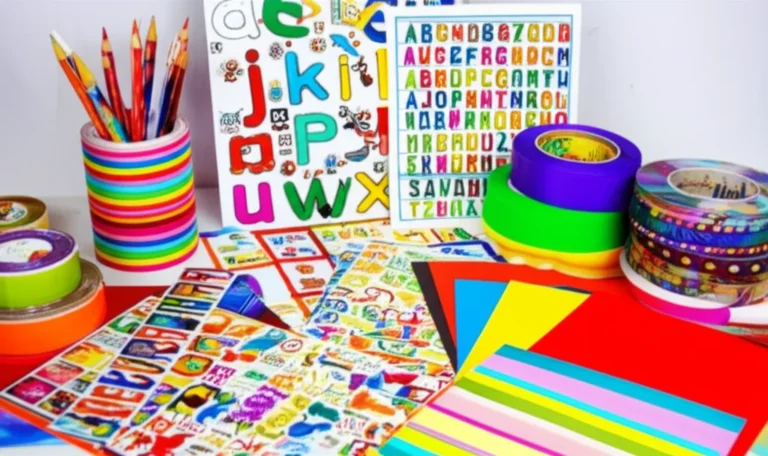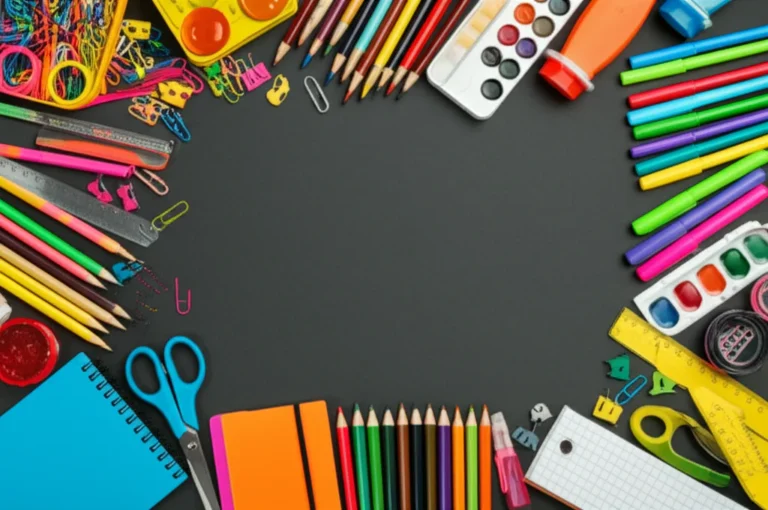Support our educational content for free when you purchase through links on our site. Learn more
What Is the Average Amount Spent on School Supplies? (2025) 🎒
Back-to-school shopping: a yearly ritual that can either spark joy or send your wallet into a panic spiral. Did you know the average family spends anywhere from $100 to over $250 per child on school supplies alone? And that’s before factoring in tech gadgets, extracurricular gear, or the surprising amount teachers themselves often shell out to keep classrooms running smoothly. Curious how these numbers break down by grade, region, and supply type? Or wondering if those pre-packaged school supply kits are worth the hype? Stick around—we’ll unpack all the costs, reveal insider tips from veteran educators, and share savvy strategies to help you save big this season.
Spoiler alert: Teachers are still quietly footing a hefty bill for classroom essentials, sometimes spending upwards of $700 annually out of pocket. But don’t worry—we’ve got expert advice on how parents, schools, and communities can lighten that load together.
Key Takeaways
- Average spending ranges from $100-$250+ per student, increasing with grade level and specialty needs.
- Teachers often spend hundreds to thousands of dollars themselves to fill supply gaps.
- Pre-packaged school supply kits offer convenience but vary in cost-effectiveness—perfect for busy families.
- Savvy shopping tips include inventory checks, bulk buying, and timing purchases around sales.
- Technology and extracurricular activities significantly add to back-to-school expenses.
👉 Shop trusted brands and categories to get started:
- Ticonderoga Pencils on Amazon | Walmart
- Crayola Crayons on Amazon | Walmart
- Elmer’s Glue Sticks on Amazon | Walmart
- Explore Classroom Supplies and Learning Materials at Teacher Supply Store™ for curated educator favorites.
Table of Contents
- ⚡️ Quick Tips and Facts: Your Back-to-School Budget at a Glance
- 📚 The Ever-Evolving Cost of Education: A Look Back at School Supply Spending Trends
- 💰 Unpacking the Backpack: What is the Average Amount Spent on School Supplies?
- 🔍 Beyond the Basics: Factors Inflating Your Back-to-School Budget
- 💡 Smart Spending Strategies: Setting a Realistic School Supply Budget
- 🍎 The Unsung Heroes: When Teachers Foot the Bill for Classroom Essentials
- 📈 The Impact of School Supply Spending: More Than Just Dollars and Cents
- 🔮 Future Forward: What’s Next for School Supply Shopping?
- Conclusion
- Recommended Links
- FAQ
- Reference Links
Here is the body of the article, written by the expert team at Teacher Supply Store™.
Welcome back to the Teacher Supply Store™ blog! We’re your go-to team of educators and supply gurus, and today we’re tackling the million-dollar question… or is it a hundred-dollar question? Let’s be real, with inflation, who can keep track anymore?! We’re diving deep into the back-to-school shopping vortex to answer: What is the average amount spent on school supplies?
Get ready, because we’re about to unpack everything from the surprising cost of crayons to the reasons why teachers are secretly funding their classrooms. Let’s get started!
⚡️ Quick Tips and Facts: Your Back-to-School Budget at a Glance
Pressed for time? Here’s the cheat sheet on school supply spending.
- The Big Number: Average spending for K-12 families on school supplies can range from $100 to over $250 per child, not including electronics or extracurricular fees.
- Teacher Spending: Believe it or not, teachers spend a shocking amount of their own money. The average educator spends between $500 and $750 annually on classroom supplies. Some spend much, much more!
- Grade Creep: Costs aren’t static! Expect to spend more as your child moves from elementary to middle and high school, where supplies get more specialized (and pricey!).
- Location, Location, Location: Where you live can impact your total spending due to regional economic factors and specific school requirements.
- Timing is Everything: Back-to-school sales are your best friend. Shopping early or late can save you a bundle compared to peak-season price hikes.
- Hidden Costs: Don’t forget items like disinfecting wipes, tissues, and hand sanitizer. These “community supplies” can add up quickly.
📚 The Ever-Evolving Cost of Education: A Look Back at School Supply Spending Trends
Remember when a fresh box of Crayola crayons and a few Mead composition books were all you needed? Ah, the good old days! Back-to-school spending has transformed dramatically over the decades. What was once a simple shopping trip has become a significant annual expense for families.
Inflation is a major culprit, of course. The National Education Association (NEA) reports that the cost of school supplies has surged by nearly 24 percent in recent years. But it’s more than just that. The very nature of Classroom Supplies has changed. The rise of technology, the need for more diverse Learning Materials, and underfunded school budgets have all shifted more of the cost burden onto parents and, as we’ll see, teachers themselves.
💰 Unpacking the Backpack: What is the Average Amount Spent on School Supplies?
So, what’s the real number? The truth is, it’s a moving target. As one source notes, “It’s important to remember that these are averages, and the actual cost can vary widely depending on your child’s school and grade level.” Let’s break it down.
Elementary School Essentials: What’s the Damage?
For our littlest learners, the list is often about creativity and community. Think crayons, washable markers, glue sticks, and blunt-tip scissors. While individual items are cheap, the quantity can be surprising!
- Average Cost: Expect to spend around $100-$150 per student.
- Key Items:
- ✅ Crayons (Crayola is the classic for a reason!)
- ✅ No. 2 Pencils (We teachers swear by Ticonderoga for less sharpener-jamming!)
- ✅ Glue Sticks (Elmer’s)
- ✅ Folders and Notebooks
- ✅ Community Supplies: Tissues, paper towels, hand sanitizer, and wipes like Clorox® Wipes.
One of our veteran kindergarten teachers, Mrs. Gable, always says, “I’d rather have a mountain of glue sticks in August than be rationing them by December!” It’s true—these basics get used up fast.
- 👉 Shop Elementary School Basics on:
Middle School Must-Haves: Stepping Up the Spending
Welcome to the jungle of middle school! This is where organization becomes key, and the supply list reflects that. Students are changing classes, managing multiple subjects, and need more sophisticated tools.
- Average Cost: The budget climbs to about $150-$200 per student.
- Key Items:
- ✅ Multi-subject binders (The bigger, the better!)
- ✅ Dividers and tabbed inserts
- ✅ Scientific calculator (The Texas Instruments TI-30XIIS is a common requirement)
- ✅ More pens, less crayons
- ✅ Combination locks for lockers
High School Hype: Preparing for the Big Leagues
High schoolers are basically pre-adults, and their supply needs can be just as complex. Specialized classes like physics, art, or advanced math require specific (and often more expensive) tools.
- Average Cost: Brace yourselves! The average can hit $200-$250 per student.
- Key Items:
- ✅ Graphing calculator (The mighty Texas Instruments TI-84 Plus is a rite of passage)
- ✅ High-quality binders and notebooks for different subjects
- ✅ USB flash drives
- ✅ Planners or digital organization apps
- ✅ Subject-specific items (e.g., lab goggles, sketchbooks, specific novels)
College Campus Costs: Beyond the Books
While not K-12, it’s worth noting that college students face a whole new level of spending. Textbooks are the notorious budget-busters, but the need for laptops, software subscriptions, and dorm supplies sends the total soaring.
Public vs. Private Schools: Does the Price Tag Differ?
This is a tricky one! You might assume private school supply lists are more extensive, but that’s not always the case. Often, higher tuition fees at private schools cover more of the basic classroom materials. Conversely, public schools, which often face tighter budgets, may rely more heavily on parents to provide supplies. The key is to check with your specific school, as policies vary wildly.
Regional Ruckus: How Location Impacts Your Ledger
The cost of living in your area directly translates to the cost of school supplies. A backpack full of gear in a major metropolitan area will likely cost more than the same backpack in a rural community. Furthermore, school funding is often tied to local property taxes, meaning schools in wealthier districts may ask for less from parents compared to those in under-resourced areas.
🔍 Beyond the Basics: Factors Inflating Your Back-to-School Budget
Why does the bill seem to grow every year? It’s not just about pencils and paper. Several factors can pump up your back-to-school total.
Teacher Wish Lists & Classroom Needs: Understanding the Ask
Ah, the infamous “Wish List.” We teachers create these not to be demanding, but to enrich the classroom environment in ways our limited budgets simply can’t cover. These lists often include:
- Flexible seating options (wobble stools, cushions)
- Books for the classroom library
- STEM kits and hands-on Learning Materials
- Art supplies beyond the basics
- Snacks for students who may not have them
“Understanding what teachers in your school are spending on classroom supplies is a critical factor in understanding how much parents or guardians or the school should cover.” When you see a wish list, you’re seeing a teacher’s effort to bridge a funding gap.
Brand Name Buzz vs. Budget Buys: The Price of Popularity
Does your child need the glitter-covered unicorn folder or the superhero backpack? Maybe not, but the pressure is real! While store brands can be fantastic, we’ll admit that for some items, the brand name really does mean better quality. (We’re looking at you again, Ticonderoga pencils!) The key is to find a balance: splurge on the items where quality counts (backpacks, binders) and save on the disposables (folders, paper).
Tech Troubles: The Growing Cost of Digital Learning Tools
Technology is the elephant in the classroom. Laptops, tablets, and reliable internet access are no longer optional—they are essential. While some schools provide devices, many have a “Bring Your Own Device” (BYOD) policy. This piece of Instructional Technology can easily become the single most expensive item on your back-to-school list. The featured video above, titled “TECH TALKER: How much is the average family spending on school supplies this year?”, provides more insight into this growing expense.
Extracurricular Expenses: Sports, Arts, and Everything In Between
Don’t close your wallet just yet! If your child is in sports, band, or drama club, get ready for another round of spending. Uniforms, instrument rentals, cleats, art kits, and travel fees are rarely included in the school’s budget.
💡 Smart Spending Strategies: Setting a Realistic School Supply Budget
Feeling the financial squeeze? Don’t panic! We’ve got decades of collective experience in stretching a dollar. Here are our top tips for a budget-friendly back-to-school season.
Savvy Shopping Secrets: How to Slash Your School Supply Spending!
- Take Inventory First: Before you buy a single crayon, raid your own house! You’d be amazed at the perfectly good scissors, rulers, and half-used notebooks hiding in drawers.
- Create a Master List & Budget: Combine the lists from all your kids. Set a firm budget. This turns shopping from a free-for-all into a mission.
- Compare Prices: Use apps and websites to compare prices between stores like Amazon, Walmart, and Target. Don’t be afraid to shop at multiple places to get the best deals.
- Buy in Bulk (Wisely): Team up with another family to buy bulk items like pencils, paper, or Ziploc® bags. You’ll all save money.
The Convenience Factor: Are Pre-Packaged School Supply Kits Worth It?
Many schools now partner with companies like School Supply Boxes or MyImpacks to offer pre-packaged, customized kits. But are they a good deal?
| Aspect | Pros ✅ | Cons ❌ |
|---|---|---|
| Convenience | Unbeatable! One click and you’re done. No crowded stores. | You can’t shop for sales or choose specific brands. |
| Cost | Can be cheaper, especially when schools get a bulk discount. | May be more expensive than hunting for deals yourself. |
| Accuracy | Guaranteed to have every exact item the teacher requested. | No flexibility for items you already own. |
Our Verdict: If you value time and convenience over finding the absolute lowest price, these kits are a fantastic option. One report suggests a good baseline cost for these kits is around $60, though it can vary by grade.
Thrifty Treasures: Embracing Second-Hand and DIY Solutions
- Backpacks & Binders: These are often built to last more than one year. A good cleaning can make them look brand new.
- Calculators: Check local buy/sell groups or ask on social media. Many families have older models they’re willing to sell for cheap.
- DIY Fun: Let your kids decorate plain, inexpensive folders and notebooks with stickers, drawings, or craft supplies you already have. It’s a great way to get them excited for school!
Maximizing Sales and Deals: Timing is Everything!
Retailers use “loss leaders”—super cheap deals on popular items like crayons or pencils—to get you in the door. The strategy? Go in, buy only the loss leaders, and leave! Stock up on these basics when they’re at their lowest price, even if it’s early in the summer.
🍎 The Unsung Heroes: When Teachers Foot the Bill for Classroom Essentials
It’s a reality many outside the education world don’t see, and our deep dive into what percentage of teachers buy their own supplies reveals a staggering trend. Educators are consistently reaching into their own pockets to provide for their students.
Why Are Educators Still Buying Their Own School Supplies? A Deep Dive
The short answer? Because school budgets are not enough. The NEA highlights that districts often fail to supply everything students need to be “engaged, comfortable, and ready to learn.” This isn’t just about extra pencils. Teachers are buying:
- Basic Supplies: To replenish what runs out mid-year.
- Student Needs: Winter coats, snacks, eyeglasses, and toiletries for students in need.
- Classroom Essentials: From tissues and cleaning supplies to flexible seating and library books.
- Curricular Materials: To supplement outdated or inadequate district-provided materials.
As special education teacher Dammian Tucker stated, “School supplies, snacks, and paper products for my class—it adds up real fast.” He spends between $1,500 and $2,000 a year. This isn’t a hobby; it’s a necessity to make the classroom function.
Bridging the Gap: How Schools and Communities Can Support Supply Needs
So what’s the solution? It’s a community effort. Some teacher unions have successfully bargained for dedicated funds for classroom spending. PTAs and PTOs often run fundraisers specifically for Classroom Supplies. When schools and parents work together, it eases the burden on everyone.
Donation Drives and Classroom Wish Lists: Making a Difference
This is where you, as a parent or community member, can be a superhero. Platforms like DonorsChoose and Amazon Wish Lists have become lifelines for teachers.
As one educator, Jamillah Bomani, decided, “If I can’t get it through DonorsChoose, an Amazon Wish List, or my PTA budget, then I just won’t have it.” Clearing a teacher’s wish list, even just one or two items, can make a huge difference in the classroom experience for dozens of students.
📈 The Impact of School Supply Spending: More Than Just Dollars and Cents
The annual back-to-school shopping spree has consequences that go far beyond a credit card bill.
Financial Strain on Families: A Growing Concern
For many families, especially those with multiple children, the cost of school supplies is a significant financial burden. When a school’s list is too demanding, it can force families to make tough choices. This financial stress is a real and growing problem.
Equity in Education: Ensuring All Students Have What They Need
This is the heart of the matter. When a child shows up on the first day without the required supplies, they start the year at a disadvantage. It can create feelings of shame and inadequacy. Ensuring every child has the tools they need to succeed is fundamental to educational equity. This is a major reason why so many teachers spend their own money—they are trying to level the playing field for all their students.
🔮 Future Forward: What’s Next for School Supply Shopping?
The world of education is always changing, and school supplies are no exception. What does the future hold?
The Rise of Digital Supplies: Less Paper, More Pixels?
We’re seeing a slow but steady shift towards digital. Subscription-based learning apps, e-textbooks, and collaborative online tools are becoming more common. While this may reduce the need for paper and pencils, it introduces new costs for software and reliable Instructional Technology.
Sustainable Solutions: Eco-Friendly Choices for the Classroom
More and more, parents and educators are looking for sustainable options. Think refillable pens, recycled paper notebooks, and non-toxic art supplies. Brands that prioritize eco-friendly manufacturing are gaining popularity. This trend is a win for the planet and teaches students valuable lessons about conservation.
Conclusion
After unpacking the many layers of school supply spending, one thing is crystal clear: the cost of equipping a student for success is no small matter. From the humble crayon box to high-tech calculators, the expenses add up quickly—and often unexpectedly. Whether you’re a parent, guardian, or educator, understanding the average amounts spent at each grade level, the hidden costs, and the reasons behind teacher out-of-pocket spending empowers you to plan smarter and advocate for better support.
We’ve seen that elementary school supplies hover around $100-$150, middle school climbs to about $150-$200, and high school can reach $250 or more. Add in technology needs and extracurriculars, and the budget balloons further. But don’t despair! Savvy shopping strategies, including early sales, bulk buying, and considering pre-packaged supply kits, can help you save time and money.
Speaking of kits, our take is that pre-packaged school supply kits are a fantastic convenience for busy families, especially when schools partner with reputable providers like MyImpacks or School Supply Boxes. They offer accuracy and ease, though they may not always be the cheapest option. For those who love a bargain hunt, mixing budget buys with trusted brands like Ticonderoga pencils and Crayola crayons strikes the perfect balance.
Finally, the elephant in the classroom: teachers spending hundreds to thousands of dollars out of pocket to fill gaps left by underfunded schools. This reality underscores the importance of community support, donations, and advocacy for better school funding. When we all pitch in, every student gets a fair shot at learning.
So, next time you’re staring at that school supply list, remember: you’re not alone, and with a little planning, you can conquer the chaos and keep your wallet happy. 🎒💸
Recommended Links
👉 CHECK PRICE on:
- Ticonderoga Pencils: Amazon | Walmart | Ticonderoga Official Website
- Crayola Crayons: Amazon | Walmart | Crayola Official Website
- Elmer’s Glue Sticks: Amazon | Walmart | Elmer’s Official Website
- Texas Instruments TI-30XIIS Calculator: Amazon | Walmart
- Texas Instruments TI-84 Plus CE Graphing Calculator: Amazon | Texas Instruments Official Website
- Clorox® Disinfecting Wipes: Clorox Official Website | Amazon
Recommended Books on Amazon:
- The Organized Student by Donna Goldberg — Tips on managing school supplies and study habits.
- Back-to-School Supplies: A Parent’s Guide — Comprehensive guide to budgeting and shopping for school supplies.
- Teaching with Less: How Educators Can Save Money and Still Deliver — Insights into teacher spending and classroom management.
FAQ
What are the essential school supplies that every student needs?
Every student needs a core set of supplies that form the foundation for learning. These include:
- Writing tools: No. 2 pencils (preferably Ticonderoga), pens, and erasers.
- Paper products: Notebooks, loose-leaf paper, folders.
- Art supplies: Crayons or colored pencils (Crayola is a trusted brand), glue sticks, scissors.
- Organizational tools: Binders, dividers, and pencil cases.
- Community supplies: Tissues, disinfecting wipes, and hand sanitizer.
These basics cover most grade levels, though specific needs may vary by school and grade.
How can I budget for school supplies to avoid overspending?
Budgeting starts with planning and research:
- Review the supply list early and take inventory of what you already have.
- Set a firm budget based on average costs by grade level ($100-$250).
- 👉 Shop sales and use coupons; back-to-school sales often offer deep discounts on staples.
- Consider pre-packaged kits if convenience and accuracy outweigh cost concerns.
- Buy in bulk with other families to save on consumables like pencils and paper.
Tracking your spending and sticking to your list helps avoid impulse buys.
What are some affordable alternatives to traditional school supplies?
- Store brands: Many generic or store-brand supplies perform just as well as name brands.
- Second-hand items: Backpacks, calculators, and binders can often be found gently used.
- DIY decorations: Personalize plain notebooks and folders with stickers or drawings.
- Reuse supplies: Encourage kids to use leftover supplies from previous years.
- Community swaps: Some schools organize supply exchanges or donation drives.
These alternatives reduce costs and promote sustainability.
What are the most expensive school supplies and how can I save on them?
The priciest items often include:
- Calculators: Scientific and graphing calculators can be costly. Save by buying used or renting.
- Technology: Laptops, tablets, and software subscriptions add up quickly. Check if your school offers loaner devices or discounted programs.
- Backpacks and lunchboxes: Invest in durable, quality items that last multiple years.
- Specialized supplies: Art kits, lab goggles, or musical instruments can be expensive depending on classes.
To save, shop off-season, buy used, or seek community assistance programs.
Reference Links
- National Education Association (NEA) — Why Are Educators Still Buying Their Own School Supplies?
- MyImpacks — School Supply Kits
- School Supply Boxes — Custom School Supply Kits
- Ticonderoga Pencils — Official Website
- Crayola — Official Website
- Elmer’s — Official Website
- Texas Instruments — Graphing Calculators
- Clorox — Disinfecting Wipes
- DonorsChoose — Support Classroom Projects
- Teacher Supply Store™ — Classroom Supplies
- Teacher Supply Store™ — Learning Materials
- Teacher Supply Store™ — Instructional Technology
- Teacher Supply Store™ — What Percentage of Teachers Buy Their Own Supplies? 📚 (2025)
Thanks for sticking with us through this deep dive! Now that you’re armed with knowledge, go forth and conquer that school supply list like the savvy shopper you are. 🎒✨



